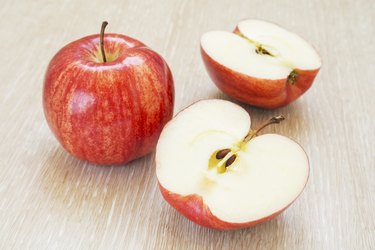
When an apple is sliced or chopped, oxygen enters the fruit's tissues and, as oxidation occurs, the flesh will turn brown as a result. While it does not affect the taste of the apple, it is unsightly. If you try to prevent this by adding acidic or basic solutions, you will find that acidic solutions work best.
Acids and Apples
Video of the Day
Acids, products that are below 7 on the pH scale, produce a sour, tart taste. When applied to cut apples, they will coat the exposed cells, and slow down the oxidization process. While you can use any acid to prevent your cut apples from browning; adding lemon, lime and pineapple juices is most often advised, as other acids, such as vinegar, introduce an unpleasant taste to the apples.
Video of the Day
To Dilute or Not
The quickest way to coat your cut apples with acid to prevent browning is to toss the pieces with a couple of tablespoons of juice. Sprinkle the juice on and then toss the slices with your hands, ensuring they are all evenly coated. However, you run the risk of not having enough juice to coat all the pieces, or having some pieces left uncoated. To avoid this, dilute the acidic juice with some water and soak the slices, tossing to coat before letting them rest.
Bases and Apples
Bases, substances with a pH level higher than 7, will not prevent apples from browning. Instead, they affect the texture of the fruit. If you add bases, such as baking soda, dissolved into water or as a powder, to apples, the cut pieces will turn mushy. Browning will still occur because the basic solution will not prevent oxidation. While baking soda can be used with water to soak dried fruits, making them softer, it is not recommended for fresh apples.
Other Options
To stop apples from browning without using acids, you can coat your apple pieces in sugar or syrup. This method works well if you are are planning on sweetening your fruit. You can also blanch the apple pieces to prevent browning. Quickly dip the slices in boiling water for a few seconds before draining. Immediately run the pieces under cold water; otherwise, they will continue cooking. Cut pieces that sit covered in water will also not brown, but the water needs to be filled to the brim of the container and then covered with a lid to ensure that the pieces remain submerged. A thin coat of water alone — with no acid — will not prevent oxidation.